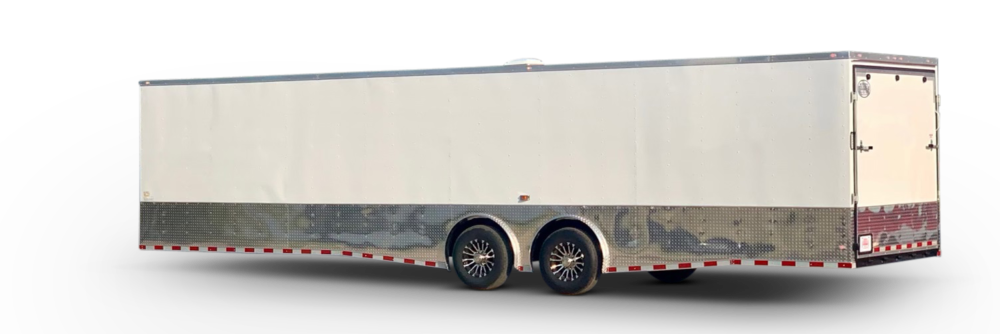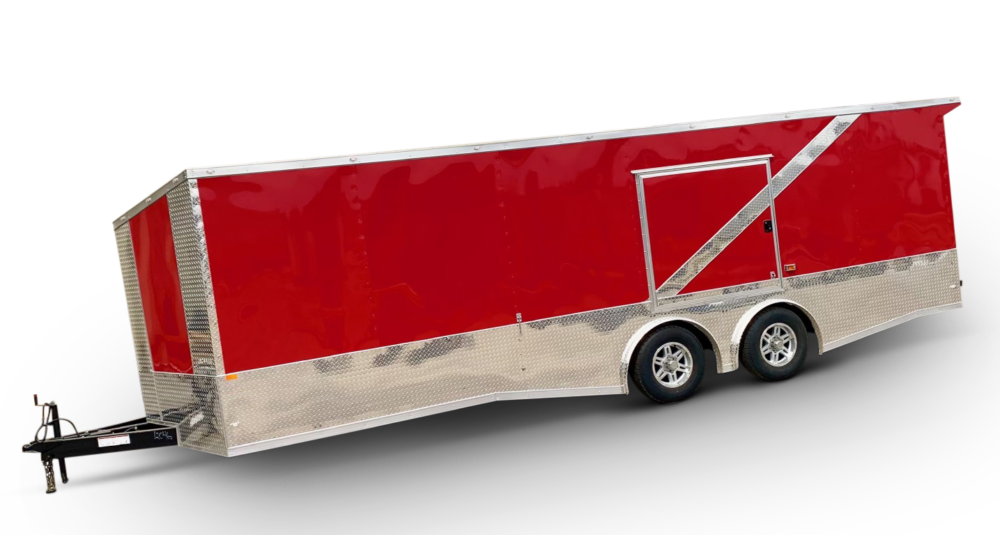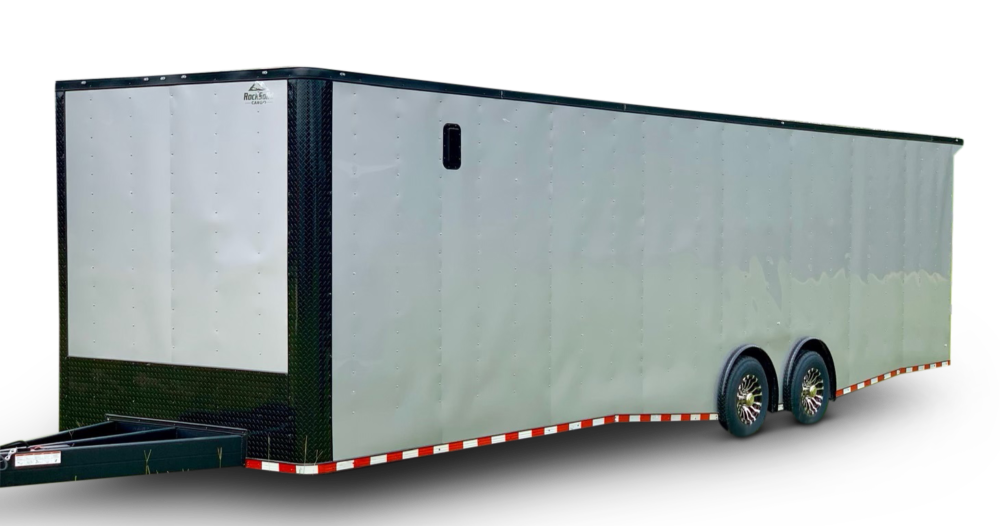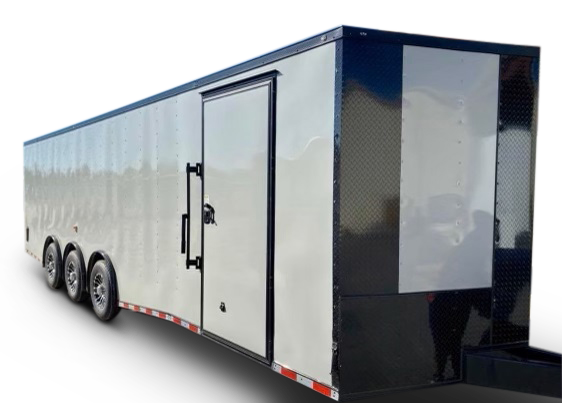
Everyone knows tandem axle trailers are great for hauling heavy loads over great distances. Most larger enclosed trailers like goosenecks and semi tractor trailers on the road utilize this familiar axle trailer configuration. However, if you’re brand new to hauling cargo, you may have never heard of a less common variant, the spread axle trailer.
In today’s trailer feature, we’ll deep dive into the great wide world of spread axle trailers and highlight the major pros and cons of this unique trailer type.
What is a Spread Axle Trailer?

The spread axle trailer, aka the split axle trailer, has a greater distance between its two rear axles. On a tandem axle trailer, there’s usually no more than a few feet of separation. However, for a spread axle trailer, you can see spaces between axles in excess of ten feet on larger trailers.
Having the space between the axles be a little greater allows a spread axle trailer to have more stability, especially when it comes to getting cargo on and off the trailer. This configuration also helps distribute the weight of the cargo better and with a greater degree of flexibility for loading cargo than is afforded with a tandem axle trailer. Spread axle trailers do require some special considerations, especially as it pertains to trailer weights.
Know Your Limits: How Much Weight on a Spread Axle Trailer?
Even though spread axle trailers are able to handle heavy loads, knowing exactly how much your trailer can safely tow is a no brainer when it comes to handling your trailer like a pro. There’s several important trailer weight measurements you should be aware of as you start calculating how much weight you can haul with a spread axle.
- Gross Combined Weight Rating (GCWR): this is specified by the tow vehicle’s manufacturer and is the total weight of the tow vehicle and the trailer together. This is the safe limit for the loaded vehicle (think passengers, gear, etc.) and a trailer loaded with cargo and should never be exceeded.
- Payload Capacity: this limit is specified by the trailer’s manufacturer and is the safe weight limit that the trailer can carry. This important measurement is the combination of a trailer’s empty or “curb” weight and all of it’s cargo. You should always make sure that the total weight of your trailer and cargo are under the trailer’s payload capacity. Exceeding this puts greater strain on the trailer’s vital gear like the axles and tires and will make it harder to handle.
- Towing Capacity: this measurement is also specified by your vehicle’s manufacturer and is the safe limit for the total weight the tow vehicle can handle. The towing capacity varies significantly depending on the vehicle. For example, the 2020 Ford F150 3.5L EcoBoost V6 has a maximum towing capability of 13,200 pounds whereas the 2020 Nissan Titan XD Crew Cab has a towing capacity up to 11,040 pounds.
If spread axle trailer weights have you scratching your head, don’t sweat it! The dedicated trailer pros at Renown will work with you to understand your unique towing needs and can recommend the perfect solution to fit the bill.
Points to Remember on Split Axle Trailer Weight Limits:
- Split Axle Trailer Weight Limits
Split axle weight limits depend on the weight rating for the axles. With several weight “classes” for axles, customers can find the appropriate axle weight rating for what they intend to haul. When considering the total split axle trailer weight limit, be sure to stay cognisant of your vehicle’s GCWR and tow capacity, as well.
- Spread Axle Weight Limits by State
Remember that DOT axle limits and other weight limits can vary depending on the state, so it’s always recommended to check with the FHA and your state’s DMV for the precise limits they impose. Also remember that some states like California impose restrictions on longer trailers, which can require some tweaks to different trailer components to remain in compliance with state regulations.
- Canadian Spread Axle Trailers
It’s very important to note that spread axle trailers are not allowed in all locations and this is especially true for some provinces of Canada. When you’re a long-haul cargo driver and are planning a trip across the US/Canada border, it’s vital to understand all of the rules governing trailers in all the Canadian provinces you’ll be traversing through.
Driving with a Spread Axle Trailer

Driving with a heavy spread axle trailer in tow lends a different experience and can require some tweaks to your towing habits. As a general rule of thumb, a spread axle trailer is best suited for hauling big cargo long distances.
That’s because these trailers are designed to perform better under certain conditions, are better at tracking, and offer the ability to balance the load a little easier, which is especially useful at the scales.
Loading a Spread Axle Trailer
A spread axle semi trailer can hold 20,000 pounds on each axle, which actually allows greater flexibility in the placement of large cargo. 40,000 pounds on the spread axles provides a lot of leeway when it comes to keeping it under the 80,000 limit imposed by the Federal Highway Administration.
Turning with a Spread Axle Trailer
Spread axle trailers can be harder to turn for the fact that the wheels are further apart. Their construction can also cause increased wear and tear on tires and other components handling heavy loads. These big trailers can be downright tricky when trying to get around a tight turn or when encountering a lot of other trailer traffic like at a busy loading dock. In the same way, backing up with a spread axle can be a little tougher.
Spread Axle Trailer Advantages and Disadvantages

At Renown, we always tell it like it is. Sometimes this gets us in trouble with our significant others but for our customers, they know they can always count on us to shoot them straight. When it comes to spread axle trailers, they have a lot of advantages over tandem axles but they also have some disadvantages that might not make them the best choice for your situation. We’ll highlight each category in more detail below.
Advantages of a Spread Axle Trailer
A spread axle trailer has a definitive advantage in how it handles as these trailers are better at tracking behind the tow vehicle. As well, a longer wheelbase increases stability. This also helps a spread axle trailer do better when encountering bumps and helps keep cargo secure. In general, a spread axle trailer will offer a smoother ride for hauling cargo long distances.
Spread axle trailers can also have great benefits in custom trailer set-ups like with racing trailers. Spread axles on enclosed car trailers help to balance the weight between the race car and other heavy cargo like a workbench/tool storage area in the trailer’s front portion. A spread axle trailer can also help decrease the amount of weight on the trailer tongue, which can help make sure you don’t experience an overload of the rear tires of a tow vehicle.
Disadvantages of a Spread Axle Trailer
As we stated above, a spread axle trailer can be a little harder to turn for the novice trailer hauler. These trailers also usually run a little higher in weight than their tandem axle counterparts, which can decrease the overall amount of cargo you can carry depending on your towing set-up. Also, a spread axle trailer can be tougher on the tires since a tire “scrubbing” can occur during turns. For these same reasons, the spread axle also wears out suspension components quicker than a tandem axle trailer.
Lastly, different states and locations have differing rules when it comes to how long or how heavy a spread axle trailer can be. If you’re hauling across state lines or even country borders (as with Canadian spread axle trailers), you’ll need to be more aware of the legalities of a spread axle trailer in each location you’re travelling through.
Trailer Sales Differently – A Trailer Professional’s Manifesto
As a faith-based firm, we want to be known for doing the right thing even if we never get recognized for it. This level of commitment is evident in everything we do and what has allowed our team to continue to expand. Browse our huge selection of the best cargo trailers on the market, find a great deal, checkout and even have your new trailer delivered right to your driveway. When you’re ready for a whole new trailer buying experience, call on the trailer professionals at Renown Cargo Trailers.
At Renown, we don’t do high pressure sales. We let integrity guide the way we treat customers and it shows with a truly superior level of service before, during, and especially, after the sale. We take the time to get to know your needs and only recommend what we know will fit your unique hauling situation perfectly. If we can’t do that, we’ll gladly recommend another dealer who can.

I have a gooseneck and bumper pull trailer. The gooseneck has triple 7k axles.
The bumper pull has two 7500k axles.
The limit of any trailer is the tires.
You can spread the axles all you want.
That doesn’t help with load capacity.
The tire rating trumps the axle rating all day long.
So ,I prefer to just have 3 axles rather than two spread axles because I have more weight capacity in rubber on the ground.
Not entirely true… but definitely part of the answer. Max tire load usable, depends on grade of axle bearing, which is determined by the axle tube and thus axle weight rating. The trailer load limit is a component of axel weight rating and frame point load rating.
At the end of the day, it’s not how much weight to can pull… but how much weight you can track in a straight line … and stop.